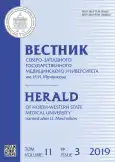Multistage treatment of a patient with spontaneous rupture of the esophagus in a multidisciplinary hospital setting
- Authors: Demko A.E.1, Sinenchenko G.I.1, Kulagin V.I.1, Ivanov V.I.1, Babich A.I.1
-
Affiliations:
- Saint Petersburg Dzhanelidze Research Institute of Emergency Care
- Issue: Vol 11, No 3 (2019)
- Pages: 93-95
- Section: Case report
- URL: https://journals.rcsi.science/vszgmu/article/view/12125
- DOI: https://doi.org/10.17816/mechnikov201911393-95
- ID: 12125
Cite item
Full Text
Abstract
The article presents a clinical case of 2-stage treatment of an elderly patient with spontaneous rupture of the esophagus. Exclusion the esophagus in the first stage of treatment with the use of minimally invasive technologies (endoscopy, laparoscopy, drainage of the pleural cavity) allowed to minimize surgical trauma and create conditions for the recovery of the patient, relief of mediastinitis, sepsis and restore the natural passage of food through the digestive tube during the second stage of treatment. The presented clinical case demonstrates the feasibility of the multistage approach using minimally invasive technology in the treatment of eldery patients with spontaneous rupture of the esophagus and severe sepsis.
Full Text
##article.viewOnOriginalSite##About the authors
Andrey E. Demko
Saint Petersburg Dzhanelidze Research Institute of Emergency Care
Author for correspondence.
Email: babichmed@mail.ru
доктор медицинских наук, заместитель главного врача по хирургии
Russian Federation, 192242, St. Petersburg, Budapestskaya 3Georgii I. Sinenchenko
Saint Petersburg Dzhanelidze Research Institute of Emergency Care
Email: babichmed@mail.ru
доктор медицинских наук, руководитель отдела неотложной хирургии
Russian Federation, 192242, St. Petersburg, Budapestskaya 3Vladimir I. Kulagin
Saint Petersburg Dzhanelidze Research Institute of Emergency Care
Email: babichmed@mail.ru
кандидат медицинских наук, заведующий отделением 5 хирургии
Russian Federation, 192242, St. Petersburg, Budapestskaya 3Vladimir I. Ivanov
Saint Petersburg Dzhanelidze Research Institute of Emergency Care
Email: babichmed@mail.ru
кандидат медицинских наук, заведующий оперблоком, врач хирург
Russian Federation, 192242, St. Petersburg, Budapestskaya 3Aleksandr I. Babich
Saint Petersburg Dzhanelidze Research Institute of Emergency Care
Email: babichmed@mail.ru
SPIN-code: 5754-3035
Candidate of medical Sciences, surgeon
Russian Federation, 192242, St. Petersburg, Budapestskaya 3References
- Brinster CJ, Singhal S, Lee L, et al. Evolving options in the management of esophageal perforation. Ann Thorac Surg. 2004;77(4):1475-1483. https://doi.org/10.1016/j.athoracsur.2003.08.037.
- Schmidt SC, Strauch S, Rösch T, et al. Management of esophageal perforations. Surg Endosc. 2010;24(11):2809-2813. https://doi.org/10.1007/s00464-010-1054-6.
- Schweigert M, Sousa HS, Solymosi N, et al. Spotlight on esophageal perforation: a multinational study using the Pittsburgh esophageal perforation severity scoring system. J Thorac Cardiovasc Surg. 2016;151(4):1002-1009. https://doi.org/10.1016/j.jtcvs.2015.11.055.
- Vallböhmer D, Hölscher AH, Hölscher M, et al. Options in the management of esophageal perforation: analysis over a 12-year period. Dis Esophagus. 2010;23(3):185-190. https://doi.org/10.1111/j.1442-2050.2009.01017.x.
Supplementary files







